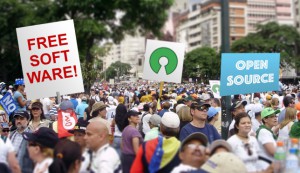5 Reasons Why Software Should Be Free and Open Source
— August 18, 2016
The Case for Free and Open-Source Software
Software has become an integral part of modern life. From personal devices like smartphones and laptops to the systems powering businesses and governments, software controls and shapes our digital experiences. As the world continues to shift towards an increasingly connected future, the way we interact with software will have lasting consequences. One important movement in this space is the idea that software should be free and open source. This approach is more than just a technical preference; it carries with it significant benefits for users, developers, and society at large. Below, we will explore the reasons why free and open source software matters.
1. Free Software Sticks Around
The software can disappear quickly. A popular app might be discontinued overnight, an update might change the software in ways that frustrate users, or a developer might abandon a project altogether. The primary reason that open-source software endures while proprietary alternatives fade is its accessibility. When software is open source, anyone can access the source code, modify it, and keep it alive even if the original developer stops supporting it.
Unlike proprietary software, which only functions as long as it is supported by a specific version of an operating system or service, open-source software has the potential to live indefinitely. For example, if you use an old version of Windows software, it might work perfectly fine today but could break in future OS updates. Mobile apps face an even more extreme version of this issue; companies can remove software from app stores at any time, effectively erasing access to it for users. Cloud-based software, in turn, is reliant on the company’s servers being active and the business continuing to operate. If the company shuts down, so does the software.
Free software’s ability to be accessed, updated, and modified by anyone means that it can continue to work even when it falls out of favor or the original developer is no longer maintaining it. Many applications in the Linux ecosystem, for instance, continue to be available even if the original developer has moved on. This ensures that users are not left stranded or dependent on a company’s whims.
2. You Can Truly Own Your Software
When you pay for proprietary software, what you’re actually purchasing is a license to use it, not the software itself. This means that the developer can limit how, when, and where you can use the software, and can even stop offering support or updates at any time. This lack of ownership is particularly problematic when software becomes obsolete or a company goes out of business, rendering the product useless or unsupported.
By contrast, open-source software allows you to truly own the program you use. When the source code is open, you can not only use the software as it is, but you can also modify it or even keep using it if the original developers abandon it. For example, if you’ve been using an app to organize your personal data for years, you don’t have to worry about the app disappearing and taking your data with it. Even if the developers cease support, someone with the necessary skills can continue maintaining the software or migrate your data to another platform. This level of freedom and control is vital for users who value long-term stability.
Moreover, owning your software means that you can customize it for your needs. If there is a feature missing, you can add it, and if the software behaves in a way that doesn’t suit your workflow, you can fix it. This autonomy is one of the strongest appeals of open-source software.
3. You Extend the Life of Hardware
The constant cycle of upgrading devices is a major concern for many people. New hardware is released regularly, with companies pushing users to upgrade to the latest versions. Software plays a big role in this, as operating systems and programs become more demanding, making older hardware obsolete. This leads to unnecessary waste, as people are forced to replace perfectly functional devices just to keep up with new software requirements.
Free software can extend the life of older hardware. Unlike proprietary software that often requires the latest system updates and hardware upgrades to run smoothly, open-source software like Linux can run on a wide variety of older machines. This is particularly helpful in reducing e-waste and allowing users to make use of hardware that might otherwise be discarded. For instance, a ten-year-old laptop might no longer run the latest version of Windows, but it could run a modern Linux distribution efficiently, giving the hardware a second life.
In this way, free and open source software helps to break the cycle of planned obsolescence, a practice that forces consumers to replace devices more often than necessary. The freedom to use software on older devices not only saves money but also promotes environmental sustainability by reducing the demand for new hardware.
4. Income Isn’t a Factor
In many parts of the world, especially in developing countries, the cost of proprietary software is a significant barrier. Commercial software often comes with a hefty price tag, which may be unaffordable for individuals, schools, or small businesses. For example, software like Microsoft Office or Adobe Photoshop might be out of reach for students or budding entrepreneurs who need these tools but cannot afford them.
Free and open source software bridges this gap by offering quality alternatives at no cost. For instance, open-source programs like LibreOffice can replace expensive office suites, and GIMP can provide similar functionality to Photoshop without the hefty price tag. These tools allow people from all socioeconomic backgrounds to gain the skills they need to succeed in the digital world.
When software is freely available, it opens up opportunities for people to explore, learn, and create. A young student with limited financial resources can still gain valuable experience and build skills that will help them in their career. This accessibility is crucial, as it ensures that everyone, regardless of income, has the chance to develop and thrive in the digital economy.
5. You Can Trust What’s Going On
Using proprietary software requires a certain level of trust that most people might not fully realize. When you use an app or program, you trust that the developer is not collecting your data or engaging in unethical practices behind the scenes. With closed-source software, you cannot see what the program is doing with your data. You must rely on the company’s word that it is not harvesting or misusing your information.
This lack of transparency can create discomfort and skepticism. For example, some users avoid upgrading to Windows 10 because of concerns about the operating system’s data collection practices. Microsoft’s aggressive tactics, such as pushing the upgrade through notifications and defaulting to settings that monitor user activity, have eroded trust. Users may feel like they are being surveilled or that their personal data is being sold without their consent.
On the other hand, open-source software allows you to see exactly what the program is doing. If you are concerned about privacy, you can inspect the source code and verify that the software isn’t collecting your personal data. This transparency builds trust between developers and users, ensuring that the software is used ethically. By releasing the source code, developers signal their respect for the user’s autonomy and privacy, which is increasingly important in an era of data breaches and surveillance.
Conclusion
In a world where more of our personal and professional lives are conducted online, the importance of free and open-source software cannot be overstated. By offering a guarantee of longevity, true ownership, extended hardware life, accessibility regardless of income, and trust in how data is handled, open-source software provides a foundation for a more transparent, sustainable, and equitable digital future. Whether you are a developer, business owner, or casual user, adopting and supporting open-source software can lead to better experiences, greater control, and more ethical use of technology.
As more people and organizations discover the advantages of open-source software, the movement continues to gain momentum. In countries like Vietnam, where mobile and web development are growing rapidly, open-source tools offer affordable, effective solutions that help developers innovate without being limited by high licensing costs. Companies can provide outsourcing solutions that benefit from the flexibility and transparency of open-source software, allowing them to offer better services to clients while maintaining control over their technology stack.
By continuing to promote and use free and open-source software, we ensure that technology remains a tool for empowerment rather than control, creating a digital ecosystem that values freedom, creativity, and fairness.




